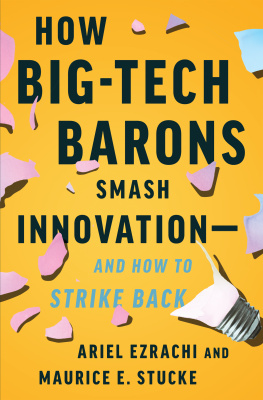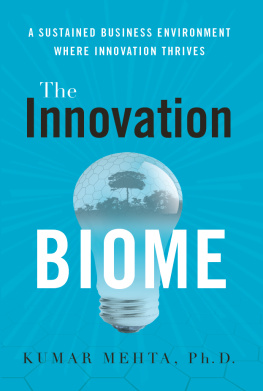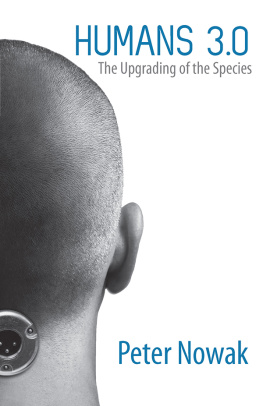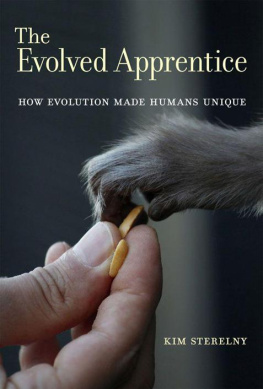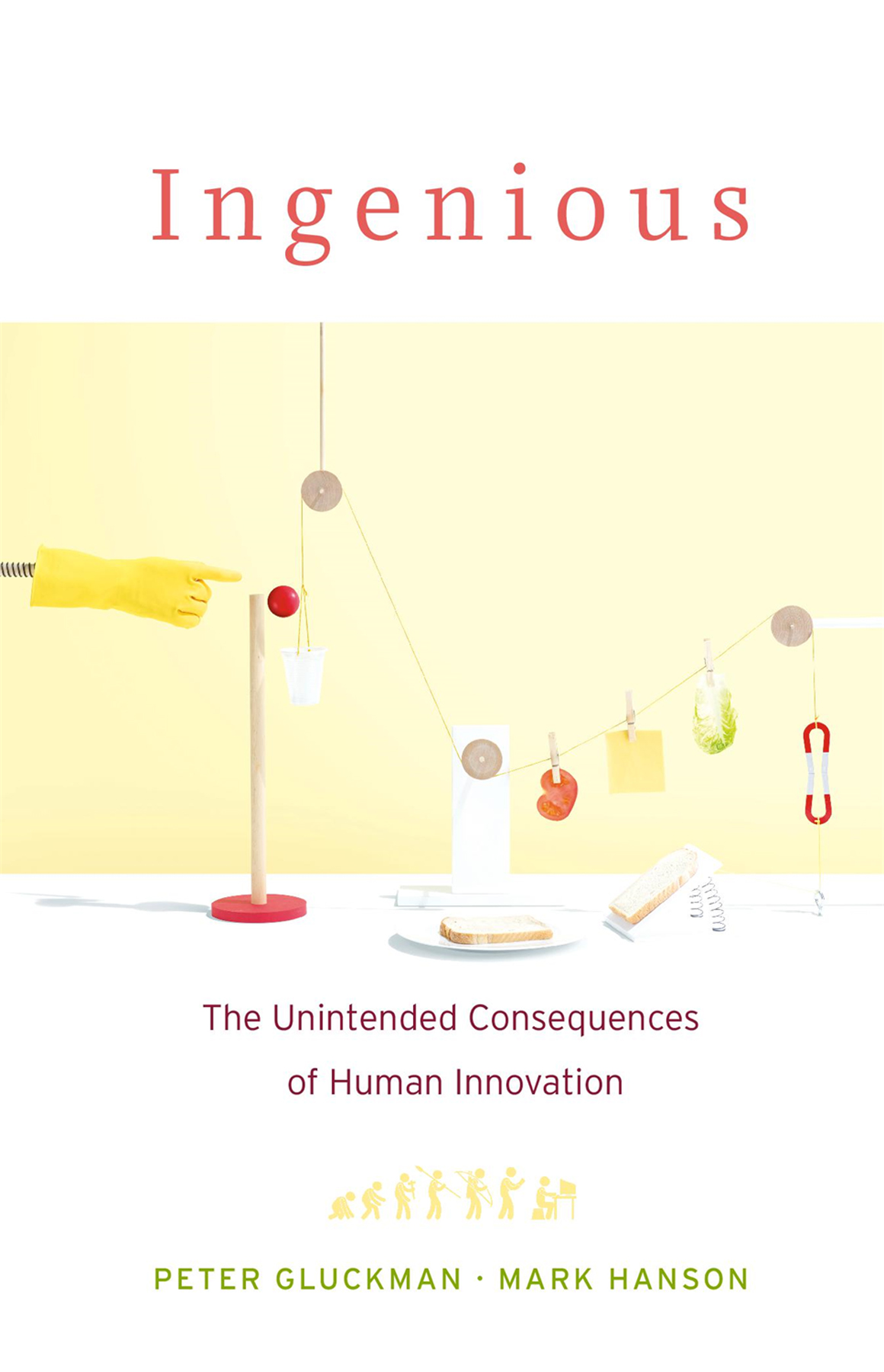Names: Gluckman, Peter D., author. | Hanson, Mark A., author.
Title: Ingenious : the unintended consequences of human innovation / Peter Gluckman and Mark Hanson.
Description: Cambridge, Massachusetts : Harvard University Press, 2019. | Includes bibliographical references and index.
Subjects: LCSH: Human evolution. | Technological innovationsHealth aspects. | Civilization, ModernHealth aspects.
WE WERE WARNED that this would not be a trip to the zoo. We were short of breathnot being acclimatized yet to the thin air at 9,500 feet above sea level. We had struggled through a steamy rain forest for three hours to reach this spot, sometimes sliding about on the path and often scrambling over tree roots. Our trousers were tucked into our socks to foil red ants, and our hands were sweating in the gloves we needed to grasp onto the spiky vegetation.
At the front of our group, a guide cut his way through vines and bamboo stems with a machete. Just when we thought we could go no deeper into the impenetrable jungle, we met three trackers. We put down our packs, took out our cameras, and followed them quietly. Suddenly there was a crashing sound above, and we looked up to see a female gorilla staring down at us.
Here, at the triple border between Rwanda, Congo, and Uganda, is the last refuge of the mountain gorilla. We moved forward cautiously and stood at the edge of a small depression. Imperiously, in the middle of it, sat a thirty-four-year-old silverback, Agashya, head of his harem. One of Agashyas sons, perhaps eighteen years old, nursed a large shoulder wound. He had fought his father for dominance in the troop, and he had clearly lost. Agashya kept a close eye on the other two younger adult males, also his sons, in the troop, and watched carefully over his harem of six adult females. They were in the bamboo, lying on the ground, grooming, or being pestered by their infants who were doing somersaults or engaging in mock battles. We knew that we must try to stay at least a few yards away from our primate cousins, but they made that impossible. Females returned from the trees, adolescents sauntered among us, and one of the younger silverbacks stood on his hind legs to grab a branch nearby.
The gorillas did not seem frightened or surprised to see us. It was us who became tense, holding our breath, uncertain of our place. This was their home and we were the intruders, high in the misty mountains of Volcanoes National Park.
We had been told not to look the gorillas in the eye because they might find it threatening, but their faces seemed so full of expression that it was impossible not to make eye contact. We were allowed to stay for an hour, mesmerized by the experience of being so close to a species so similar to us, and yet so different.
The ranger quietly told us Agashyas story. The harem had previously been that of another silverback, who had died. Rather than dispersing, the females stayed together. After some time, Agashya turned up, having crossed the border from Congo. The females had become habituated to humans over many years, and, remarkably, Agashya appeared to learn from his new wives that humans, at least those who came with rangers and guides, were not threatening.
About 98 percent of human DNA is identical to that of the gorilla. A small genetic difference has profound effects on what makes a gorilla a gorilla and a human a human. But how different are we really? Visiting their mountain habitat for that hour emphasized our similarities more than our differences. The gorillas obviously had a well-defined social structure and engaged in some complex form of communication, just as we exchanged meaningful looks with each other as we sat observing them. And there were clearly very different personalities: on the side of the hill, arms crossed in a defiant pose, one large female sat away from the group, looking antisocial. She is often in that mood, said our guide. But were we correct in attributing human emotions and feelings to these gorillas? Were they wondering about us in the same way that we were wondering about them?
Thinking about how similar gorillas are to us, and yet how enormously different, raises the age-old question: What makes us what we are? This question has occupied human minds probably for as long as we have been self-aware. To answer it, we must examine our natureas many have done, from the earliest shamans to the discourses of every subsequent cultures theologians and philosophers.
The question of what makes us what we are is not only a metaphysical exercise, though. It can be addressed scientifically. This was one of the questions Charles Darwin explored in an argument extending across his three great books: The Origin of Species, The Descent of Man, and The Expression of the Emotions in Man and Animals. A well-known diagram in one of his early notebooks, enigmatically headed I think, shows his idea of a single tree of life, by which all living and extinct organisms, from bacteria to dinosaurs, plants, insects, fishes, birds, mammals, and even humans, share a common ancestor. The mechanisms of inheritance of variations through natural selection, he suggested, were all that was necessary to explain the great diversity of the branches of the tree of life. Humans are only one small, albeit highly successful, branch.
Important to Darwins emergent thinking were his visits to Regents Park Zoo in London. He was fascinated by the emotional expressions of Jenny, the orangutan.
Through the course of evolution, human natureand here we mean something much more than just our genetic makeupand gorilla nature became wonderfully adapted to our respective environments. We share common ancestors that lived in sub-Saharan Africa some nine million to thirteen million years ago; we are cousins. But there the similarities end. Their ancestors followed an evolutionary path in West Africa, leading to the apes. Ours followed a path in what is now the Rift Valley to the east, leading to the origin of hominins.
Mountain gorillas environment has been squeezed and is now limited to a vulnerable niche in the central massif of Africa. The family group we met are secure in their habitat because humans have allowed them to be so. We paid thousands of dollars to visit them and then retreated to the safety of our camp, and after that to our homes thousands of miles away. The gorilla family would not survive even a few miles outside their traditional habitat; they are only a few miles from the Democratic Republic of Congo, where poaching is rife. They have little recourse to remedy if one of them becomes ill or injured. If the supply of their food plants diminishes, they will face starvation. Gorillas have been seen to use some simple toolssuch as a stick to judge the depth of water in a pool or to open a fruitbut they hardly have mobile phones, cars, and automatic weapons. They could never threaten our survival to any great extent, certainly not in the way we threaten theirs. We have created a niche for ourselves, too, but ours stretches across almost the entire planet.


